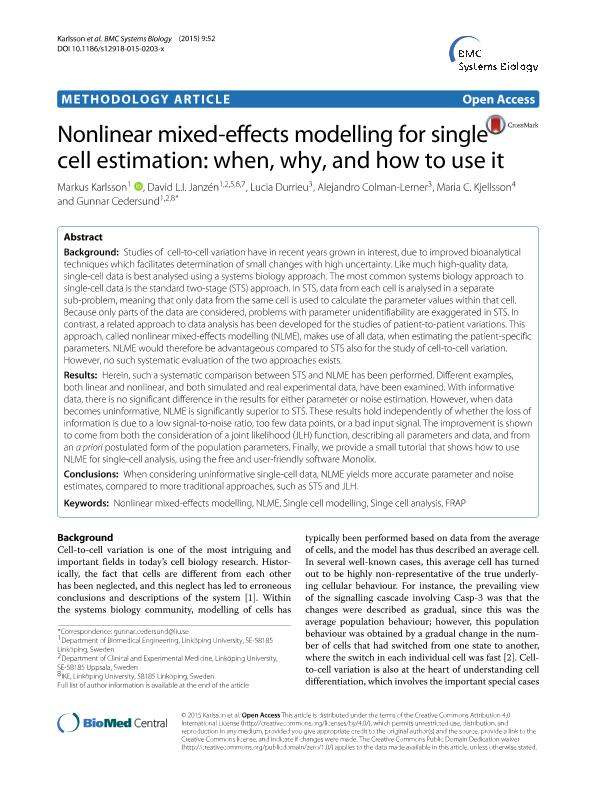Mostrar el registro sencillo del ítem
dc.contributor.author
Karlsson, Markus
dc.contributor.author
Janzén, David L.I.
dc.contributor.author
Durrieu, Lucía

dc.contributor.author
Colman Lerner, Alejandro Ariel

dc.contributor.author
Kjellsson, Maria C.
dc.contributor.author
Cedersund, Gunnar
dc.date.available
2018-09-19T20:09:12Z
dc.date.issued
2015-09
dc.identifier.citation
Karlsson, Markus; Janzén, David L.I.; Durrieu, Lucía; Colman Lerner, Alejandro Ariel; Kjellsson, Maria C.; et al.; Nonlinear mixed-effects modelling for single cell estimation: When, why, and how to use it; BioMed Central; Bmc Systems Biology; 9; 1; 9-2015; 1-15
dc.identifier.issn
1752-0509
dc.identifier.uri
http://hdl.handle.net/11336/60353
dc.description.abstract
Background: Studies of cell-to-cell variation have in recent years grown in interest, due to improved bioanalytical techniques which facilitates determination of small changes with high uncertainty. Like much high-quality data, single-cell data is best analysed using a systems biology approach. The most common systems biology approach to single-cell data is the standard two-stage (STS) approach. In STS, data from each cell is analysed in a separate sub-problem, meaning that only data from the same cell is used to calculate the parameter values within that cell. Because only parts of the data are considered, problems with parameter unidentifiability are exaggerated in STS. In contrast, a related approach to data analysis has been developed for the studies of patient-to-patient variations. This approach, called nonlinear mixed-effects modelling (NLME), makes use of all data, when estimating the patient-specific parameters. NLME would therefore be advantageous compared to STS also for the study of cell-to-cell variation. However, no such systematic evaluation of the two approaches exists. Results: Herein, such a systematic comparison between STS and NLME has been performed. Different examples, both linear and nonlinear, and both simulated and real experimental data, have been examined. With informative data, there is no significant difference in the results for either parameter or noise estimation. However, when data becomes uninformative, NLME is significantly superior to STS. These results hold independently of whether the loss of information is due to a low signal-to-noise ratio, too few data points, or a bad input signal. The improvement is shown to come from both the consideration of a joint likelihood (JLH) function, describing all parameters and data, and from an a priori postulated form of the population parameters. Finally, we provide a small tutorial that shows how to use NLME for single-cell analysis, using the free and user-friendly software Monolix. Conclusions: When considering uninformative single-cell data, NLME yields more accurate parameter and noise estimates, compared to more traditional approaches, such as STS and JLH.
dc.format
application/pdf
dc.language.iso
eng
dc.publisher
BioMed Central

dc.rights
info:eu-repo/semantics/openAccess
dc.rights.uri
https://creativecommons.org/licenses/by-nc-sa/2.5/ar/
dc.subject
Frap
dc.subject
Nlme
dc.subject
Nonlinear Mixed-Effects Modelling
dc.subject
Singe Cell Analysis
dc.subject
Single Cell Modelling
dc.subject.classification
Otras Ciencias Biológicas

dc.subject.classification
Ciencias Biológicas

dc.subject.classification
CIENCIAS NATURALES Y EXACTAS

dc.title
Nonlinear mixed-effects modelling for single cell estimation: When, why, and how to use it
dc.type
info:eu-repo/semantics/article
dc.type
info:ar-repo/semantics/artículo
dc.type
info:eu-repo/semantics/publishedVersion
dc.date.updated
2018-09-19T14:33:08Z
dc.journal.volume
9
dc.journal.number
1
dc.journal.pagination
1-15
dc.journal.pais
Reino Unido

dc.journal.ciudad
Londres
dc.description.fil
Fil: Karlsson, Markus. Linkoping University; Suecia
dc.description.fil
Fil: Janzén, David L.I.. Linkoping University; Suecia
dc.description.fil
Fil: Durrieu, Lucía. Consejo Nacional de Investigaciones Científicas y Técnicas. Oficina de Coordinación Administrativa Ciudad Universitaria. Instituto de Fisiología, Biología Molecular y Neurociencias. Universidad de Buenos Aires. Facultad de Ciencias Exactas y Naturales. Instituto de Fisiología, Biología Molecular y Neurociencias; Argentina
dc.description.fil
Fil: Colman Lerner, Alejandro Ariel. Consejo Nacional de Investigaciones Científicas y Técnicas. Oficina de Coordinación Administrativa Ciudad Universitaria. Instituto de Fisiología, Biología Molecular y Neurociencias. Universidad de Buenos Aires. Facultad de Ciencias Exactas y Naturales. Instituto de Fisiología, Biología Molecular y Neurociencias; Argentina
dc.description.fil
Fil: Kjellsson, Maria C.. Linkoping University; Suecia
dc.description.fil
Fil: Cedersund, Gunnar. Linkoping University; Suecia
dc.journal.title
Bmc Systems Biology

dc.relation.alternativeid
info:eu-repo/semantics/altIdentifier/doi/http://dx.doi.org/10.1186/s12918-015-0203-x
dc.relation.alternativeid
info:eu-repo/semantics/altIdentifier/url/https://bmcsystbiol.biomedcentral.com/articles/10.1186/s12918-015-0203-x
Archivos asociados
